Hint: There are quite a lot of them. Ineichen Zürich is hosting an auction called It’s a Date: Calendar Watches, dedicated to calendar complications. There are several classic functions in the field of complicated mechanical watches, and calendar complications are among the most popular and well-known. The perpetual calendar, almost the most complex function among them, provides maximum convenience of use: with this calendar mechanism, the watch owner does not have to somehow adjust the operation of this type of watch at all. Of course, only if he keeps the watch wound. The mechanism automatically maintains the correct date, no matter how many days a month has, and no matter what year is running – whether it is a leap year or not. And it will stay that way until the year 2100 – not a bad prospect, right? In 2100, for most perpetual calendars, comes the F-day when the date display must be corrected at the end of February when the calendar is changed to March 1, because in February 2100 there are not 29 days, as follows from the leap year cycle rule, but 28 days. An explanation is needed here: the even more complex and incredibly rare secular calendar will not require any intervention in its functioning in February 2100.
The perpetual calendar is a classic and at the same time very practical complication, which explains its popularity among watch lovers and its appeal as one of the complications of very complex mechanical watches, where the perpetual calendar is complemented by other functions such as a chronograph or a split-seconds chronograph, a minute repeater, a tourbillon, and so on.
The perpetual calendar comes in many varieties, differing by additional ‘small’ complications or the design of the calendar displays – this makes getting to know and collecting perpetual calendars exciting and enlightening. For example, it is sometimes complemented by displays such as the power reserve indicator, the week number, the equation of time, or a 24-hour day/night indicator, to name a few. On the dial of a perpetual calendar watch, there is almost always a moon phase indicator, which makes the watch beautiful and appealing and gives it an astronomical aura. Perpetual calendar displays can also differ in technical design. First of all, there is a large date display, a retrograde display of the date, day of the week or month, and a digital year display with two or even four digits, while the dial usually has a leap year display instead. The knowledgeable collector will appreciate a perpetual calendar with instant advance of calendar indications, this complication is called an instantaneous perpetual calendar.
The annual calendar is somewhat less complex than the perpetual calendar and needs to be adjusted only once a year – at the end of February. This wristwatch complication was invented by Patek Philippe in 1996, and since then several brands have developed their own versions of the annual calendar. Patek Philippe is the leader in this niche with a large number of versions and designs introduced since 1996.
Even simpler are the triple or complete calendar with date, day of the week and month display and the double calendar with date and day of the week display.
The simplest calendar is the date display in an apperture, which was introduced to watchmaking by Rolex in 1945 with the Datejust watch. It is now considered a standard feature on wristwatches and is not even considered a complication. However, the same cannot be said for the more complex version of this feature, the large date display, sometimes referred to as the big date, which was introduced to modern watchmaking by A. Lange & Söhne. This practical and easy-to-read complication appeared in 1994 in the famous Lange 1 watch. Since then, watchmakers have used this display in various complications, most notably in the perpetual calendar, although watchmakers make many watches with the big date as the only complication or in various combinations with other functions.
Oddly enough, a classic perpetual calendar that has only the standard calendar displays and no moon phase display is very rare. A version with a moonphase and a 24-hour day/night indicator, which is very useful when you are setting a perpetual calendar mechanism to a correct date, is available on three Patek Philippe watches that are on the It’s a Date: Calendar Watches auction. This is the Perpetual Calendar Ref. 3940G ‘Silvery Moon and Stars, Transitional Dial’ (Lot 11), Perpetual Calendar Ref. 5040G-018 (Lot 29), and Perpetual Calendar Ref. 5940J-001 (Lot 28) This is a rare opportunity to see a trio of perpetual calendars from Patek Philippe with the ultra-thin mini-rotor caliber 240 Q at a single auction.
Besides the fact that Ref. 3940 is considered a historically important reference, which has become the symbol of Patek Philippe art of complication watches since its introduction in 1985. It is undoubtedly one of the most important releases of the brand under its former president Philippe Stern, and it is interesting to note that he said in many interviews that Ref. 3940 was his favorite watch that he wore every day. This reference was the clearest proof that at the end of the crisis in the Swiss watch industry, which became known as the quartz crisis, Patek Philippe was ready to respond quickly to the public’s renewed interest in complex mechanical watches. For this reason, the Ref. 3940 has a unique status and is perceived today as an extremely attractive collector’s watch, especially because this reference was discontinued in 2007. A detailed historical overview published by acollectedman.com informs that the total production of Ref. 3940 was between 7,000 and 8,000 pieces, while the release of the third generation of the reference, which includes this Perpetual Calendar Ref. 3940G ‘Silvery Moon and Stars, Transitional Dial’ (Lot 11), counts about 2,200 pieces in the 12-year production period (1995–2007). The majority of the run consisted of yellow gold models; white gold watches are rarer, as are rose gold and platinum models. But that’s not the only thing that makes this watch remarkable. We suggest you turn your attention to the dial, which features a very interesting combination of the ‘Sigma’ lettering aligned to the outer minute track, typical of this third-generation watch, and the two-tone 24-hour counter, corresponding to the dials of the first and second series watches. Also noteworthy is the font used to mark the sub-dials, namely the shape of the letter J in the month names; in these watches it resembles the dials of the second generation, so we refer to this dial as a transitional type with features from the end of the second series and the beginning of the third series. We also note that Ref. 3940 has two options for the finish of the lunar disc and the stars on the moon phase indicator: a yellow gold tone and a silver tone. Acollectedman.com points out that the second version is a rare variant. This watch has a silvery-lunar disc and stars, a feature that makes it even rarer and increases its collector value.

Perpetual Calendar Ref. 5040G-018 (Lot 29) in white gold was designed as a tonneau-shaped alternative to the classic round Ref. 3940. It was also Patek Philippe’s first serially produced perpetual calendar with Breguet numerals on the dial. The tonneau-shaped case design of the 5040 seems to be a clear nod to Patek Philippe’s early historical perpetual calendars from the 1920s and 1930s, which often had the same case shape. The case of the 5040 has an extravagant design with a monobloc case ring and a bezel made of a single piece of metal, with no attached bezel – a typical design for Patek Philippe tonneau-shaped watches. Ref. 5040 was introduced in 1992 and discontinued in 2007. Production was divided into three series: For the first series, the movement numbers start with ‘77’, and the movements of the second series, produced around 1998, have serial numbers 312xxxx. This watch belongs to the second series of Ref. 5040. The third, last series received movements with serial numbers 367xxxx. Please note that the differences in design and execution of the watches from the three series have not yet been discovered. Most 5040s were cased in yellow gold, then in platinum, in white gold, and in a very limited number in rose gold. It is estimated that no more than 4,000 pieces of the Ref. 5040 were made in all metals, although Phillips says that a total of about 3,350 were made, while only 500 were cased in white gold. The 5040 in white gold was offered in two versions: with a white matte silvered dial and with a black dial. The first version, like the present example, is the rarer one – we estimate that models with a black dial are about twice as common as those with a white dial, which undoubtedly adds to the appeal of this lot.
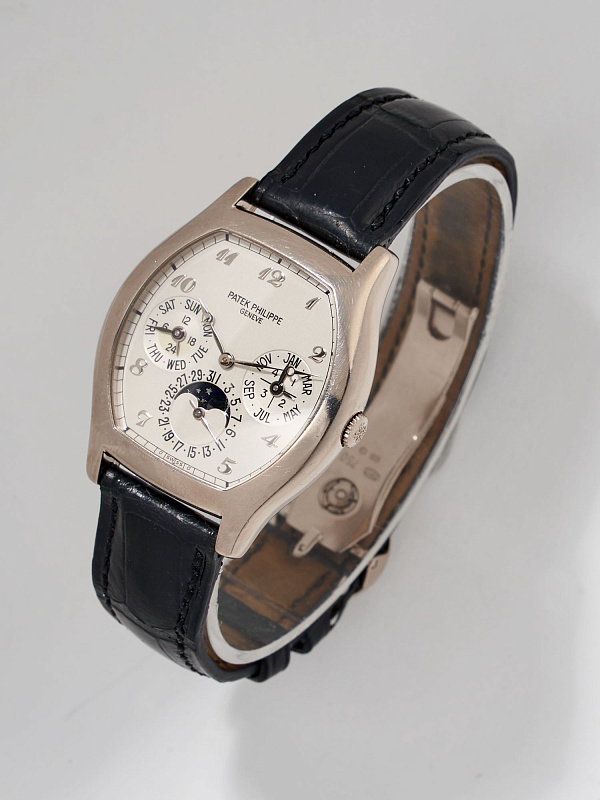
Perpetual Calendar Ref. 5940J-001 (Lot 28) is one of the few Patek Philippe perpetual calendars available in a cushion-shaped case. Patek Philippe introduced this reference in 2012 as a replacement for the earlier exquisite tonneau-shaped perpetual calendar Ref. 5040, which is also offered in this auction. Ref. 5940 was originally in yellow gold (like the present example), while rose and white gold watches were only launched in 2014. What sets this watch apart from many other perpetual calendars is its outstanding Art Deco style, evident in both the case shape and the design of the dial, which features valuable signs of Patek Philippe watchmaking. These include the ‘chemin de fer’ minute track and the applied Breguet-style Arabic numerals. The ‘chemin de fer’ minute track is only found on the yellow gold Ref. 5940 watches. Therefore, we consider this watch a must-have for any connoisseur who wants to assemble a representative collection of Patek Philippe perpetual calendars.
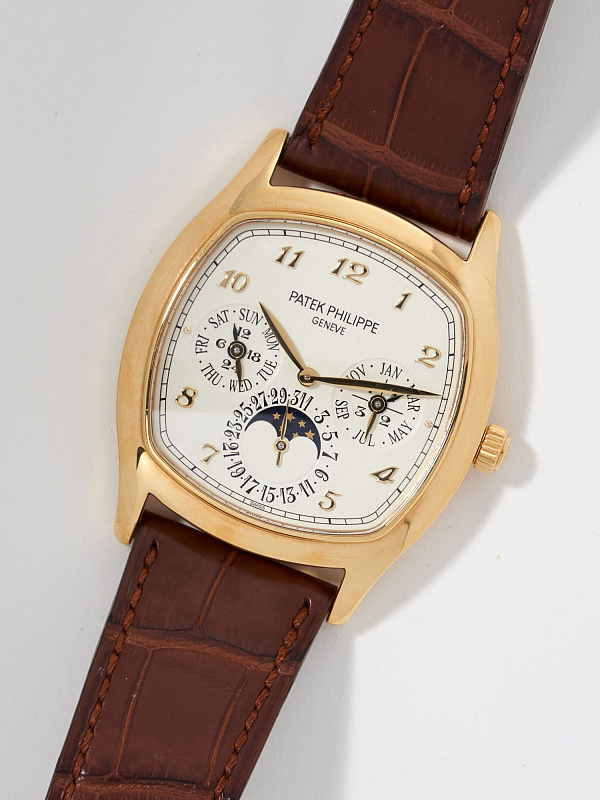
An example of a laconic approach to the design of a perpetual calendar are the early Audemars Piguet classic-style automatic wristwatches produced by this brand from the late 1970s to the mid-1990s. In fact, the brand did not consider it necessary to equip its perpetual calendars with a leap year indicator, although it was the inventor of this complication that appeared on the dial of its perpetual calendar wristwatches in the 1950s. Audemars Piguet Quantième Perpétuel Automatique Ref. 25657BA (Lot 17), sold to its original owner in 1988, is an example of such laconic design. The second generation of Audemars Piguet perpetual calendar watches was produced under reference 25657, in parallel with the first-generation reference 24558, which is a late designation of the original reference 5548 introduced in 1977. Ref. 25657 has a harmonious white matte dial and ‘sunken’ sub-dials, which are the hallmark of the second-generation watch. It is based on the ultra-thin 2120/2800 self-winding caliber, which is essentially the same caliber that ticks in the 1980s and 1990s Royal Oak Quantième Perpétuel, which has traded high at recent auctions. Ref. 25657 was made in 1821 pieces in all versions, 1309 of them in yellow gold.
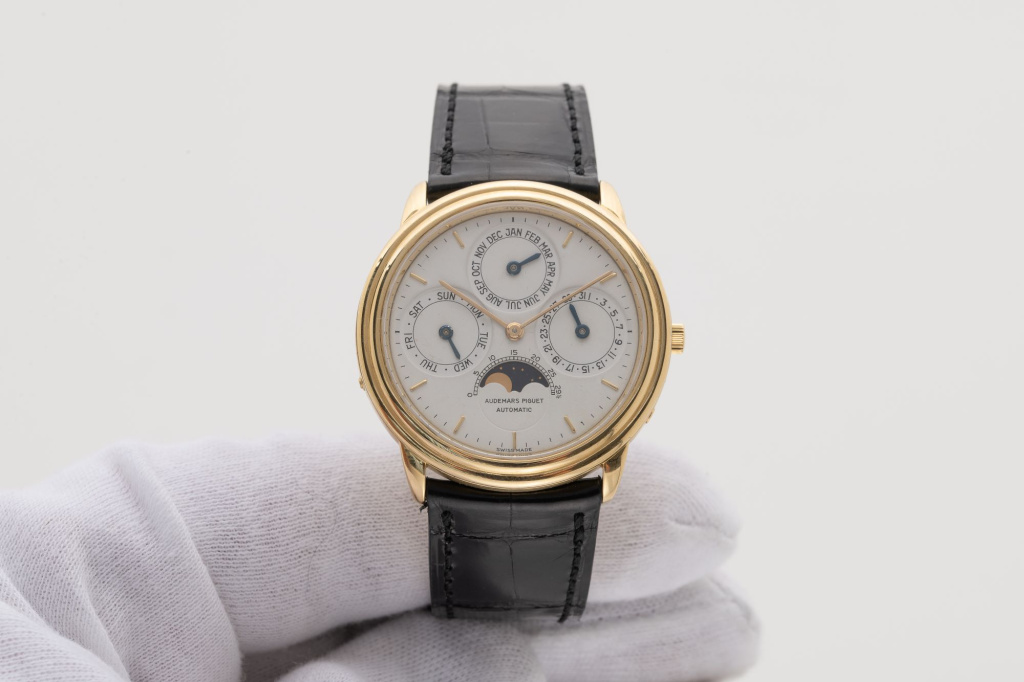
Audemars Piguet Code 11.59 Perpetual Calendar Ref. 26394OR.OO.D321CR.01 (Lot 16) in rose gold with blue aventurine dial and sub-dials is a representative of the latest generation of perpetual calendars from this brand. It features the ultra-thin central rotor caliber, which was redeveloped a few years ago for the current Royal Oak and Code 11.59 collections. It has the usual extended perpetual calendar indications typical of Audemars Piguet’s current collection, including the date, the day of the week, the month, the leap year indicator and the central hand for the week number. This watch features one of the most decorative designs for a perpetual calendar. Moreover, perpetual calendars with an aventurine dial are extremely rare, so this watch is worth a look.
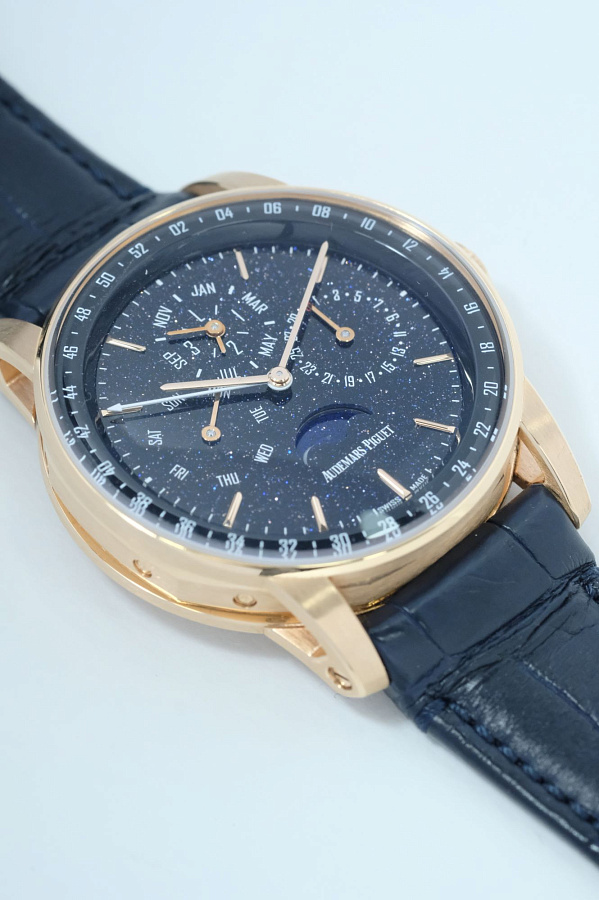
Two Roger Dubuis watches offered at the It’s a Date: Calendar Watches auction feature classic perpetual calendar indicators: The rare self-winding Sympathie Perpetual Calendar Ref. SY43 1439 5 (Lot 14) in rose gold, no. 19 in a limited edition of 28, with a mother-of-pearl dial in the spectacular Art Deco style typical of Roger Dubuis watches of the 2000s, and the rare Much More Perpetual Calendar (Lot 25) with an exquisite elongated rectangular case in white gold, no. 16 in a limited edition of 28 pieces made in the late 1990s to early 2000s.
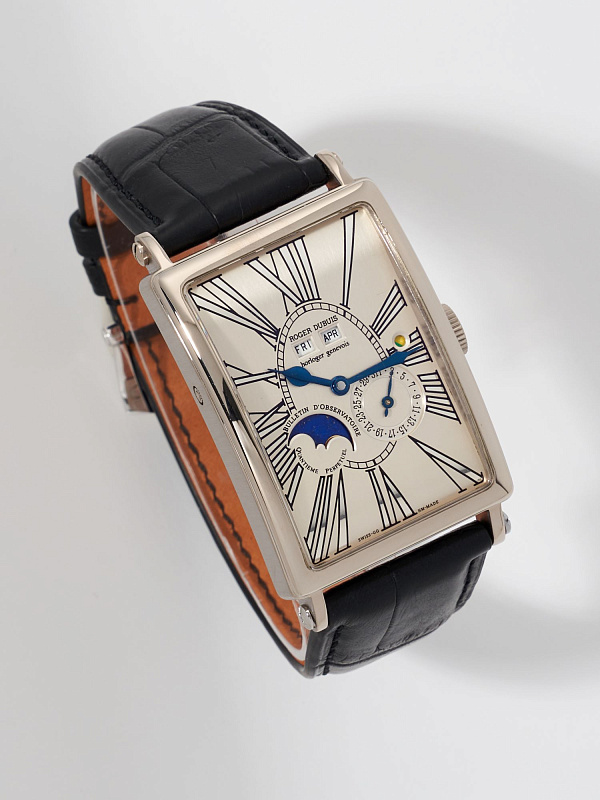
A peculiar version of the classic perpetual calendar complication can be found in the self-winding Daniel Roth Perpetual Calendar Moon Phases Ref. 118.L.60 Numero 26 (Lot 26) in white gold. It is a representative of the second generation of Daniel Roth perpetual calendars, based on a Girard-Perregaux GP3000 movement and manufactured in the early 2000s. The auction also features another Daniel Roth perpetual calendar watch, the Instantaneous Perpetual Calendar Ref. 119.X.70 (Lot 27), which differs from the previous watch by the mechanism for instantaneous switching of the perpetual calendar displays, as well as by the openworked dial that reveals a view of the calendar module decorated with exquisite engraved floral patterns. Both Daniel Roth perpetual calendars are a must-have for the discerning collector, as they are distinctive and highly prized examples of the genre.
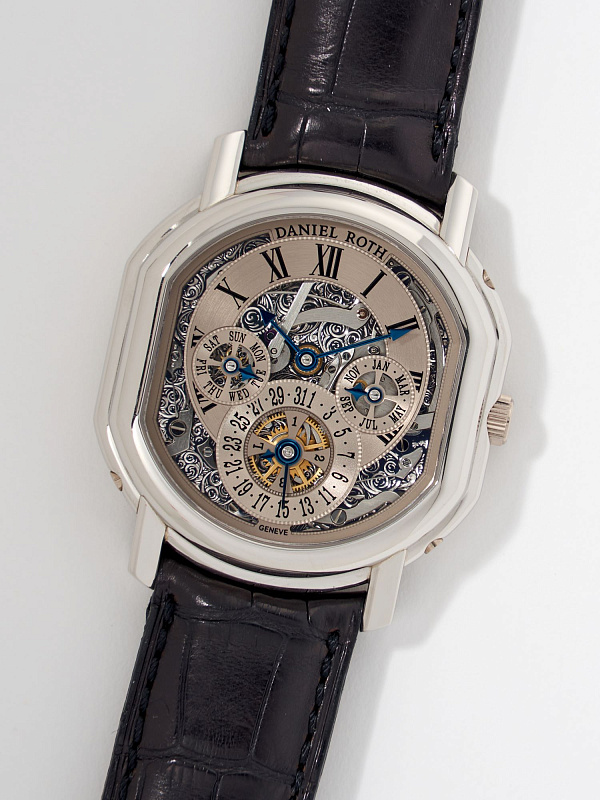
The following three lots, 21, 22 and 23, represent perhaps the best of Franck Muller’s perpetual calendars. The brand created a grand interpretation of the Art Deco style in the mid-1990s, finding its most refined expression in the watches of the Cintrée Curvex collection and its sporty offshoot Casablanca, which differs from the parent collection with luminous markers and luminous sword-shaped hands. We consider the Cintrée Curvex and Casablanca perpetual calendars to be some of the most beautiful and collectible Franck Muller watches. In the self-winding Cintrée Curvex Perpetual Calendar Ref. 6850 QP No. 63 (Lot 21) in rose gold, we find a classic version of the perpetual calendar complication with date, day of the week, month, leap year and moon phase, as well as a cross-shaped counter arrangement, while the Casablanca Perpetual Calendar Ref. 5850 QP24 No. 133 (Lot 22) in rose gold and the Cintrée Curvex Perpetual Calendar Ref. 5850 QP24 No. 43 (Lot 23) in rose gold have an additional 24-hour counter (it covers Tuesday on the weekday sub-dial), which is very useful when installing perpetual calendar. We find that it robs the dial of its symmetry, making it more distinctive, memorable and attractive.
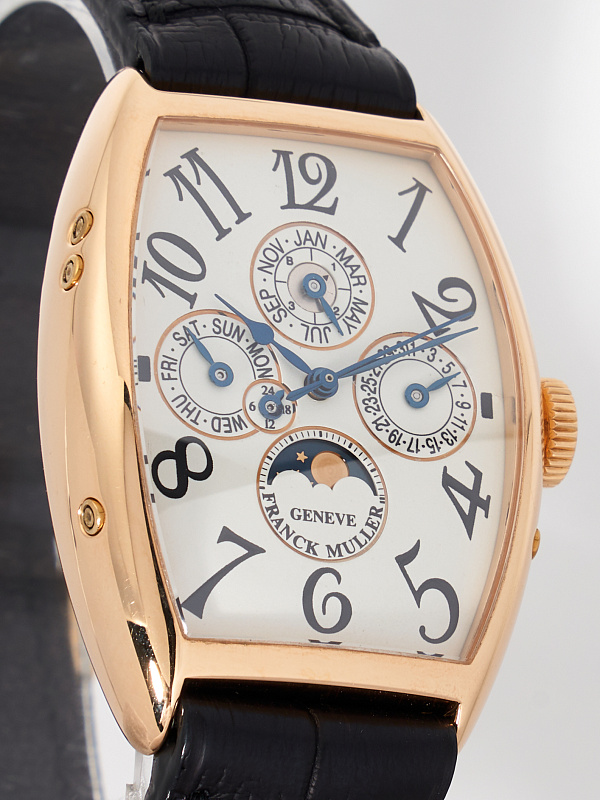
The auction also offers another perpetual calendar by Franck Muller – the self-winding Perpetual Calendar Equation Chronograph Ref. 7000 QPE No. 33 (Lot 07) in white gold with a chronograph and a perpetual calendar with retrograde month display, marked by the equation of time. This design is the trademark of Franck Muller and can be found only in the brand’s collection.
Self-winding Jaeger LeCoultre Odysseus Perpetual Calendar Ref. 166.7.80 (Lot 09) in rose gold has two very interesting features. Instead of a leap year indicator, this watch has a two-digit year display, which is rare for perpetual calendars. It is believed that Jaeger LeCoultre originally obtained this complication from IWC Schaffhausen when both brands were part of the LMH Group. IWC Schaffhausen provided Jaeger LeCoultre with the technical plans for the perpetual calendar module designed by Kurt Klaus in 1985. In addition, this watch is a version of the Odysseus Perpetual Calendar with a red zone on the central 24-hour indicator, which serves as a warning and prevents the calendar mechanism from being adjusted from 22:00 to 03:00, when it could be damaged.
Jaeger LeCoultre Master Eight Days Perpetual Ref. 174.8.26.S (Lot 08) shows the brand’s alternative approach to developing a perpetual calendar. The caliber 876 of this watch is one of several movements from the brand that have an extended power reserve – in this case, 8 days. It’s only natural that such a movement would have a power reserve indicator, and the dial also has a day/night indicator and a full four-digit year display – a very rare feature on perpetual calendar wristwatches.
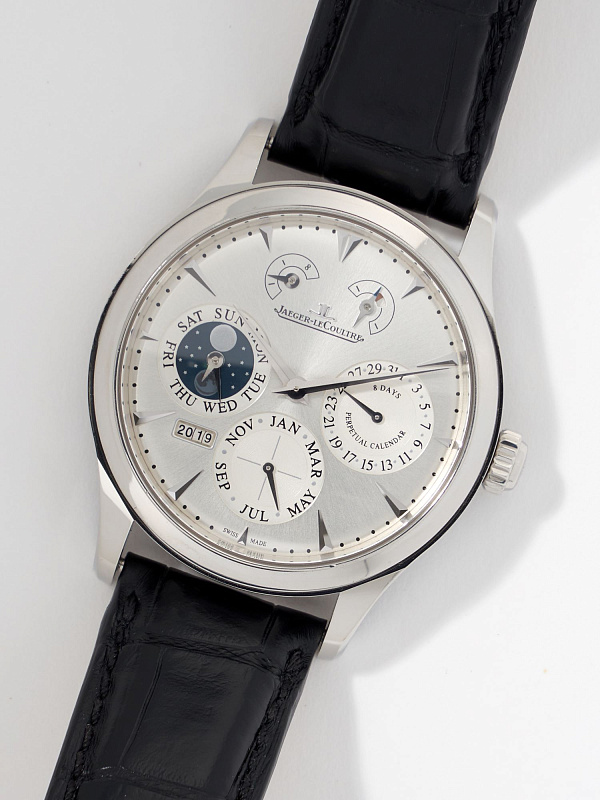
IWC Schaffhausen Portugieser (Portuguese) Perpetual Calendar Ref. IW503202 (Lot 18) in rose gold has a long power reserve of seven days and a full four-digit year display. IWC Schaffhausen and Jaeger LeCoultre are the only brands that regularly give their perpetual calendars such a display. This watch also received a power reserve indicator, its own Pellaton self-winding system, a dual moon phase indicator for the northern and southern hemispheres, and a very nice large caliber.
The two-digit year display is one of the main features of the white gold Ulysse Nardin Perpetual Ludovico Ref. 330-48 No. 018 (Lot 24) This watch deserves the most attention, because its self-winding caliber embodies the world’s first perpetual calendar, which allows to set the date both forward and backward. This mechanism is an invention of Dr. Ludwig Oechslin, the former technical genius of Ulysse Nardin. In the modern collection of Ulysse Nardin there are no watches with a perpetual calendar developed by Oechslin, although this is a wonderful page in the history of the venerable watch brand.
Breguet Perpetual Calendar Ref. 5327BA/1E/9V6 (Lot 03) in yellow gold, sold to the original owner in 2006, is part of the fine perpetual calendar tradition of this brand, whose founder was recognized for his valuable historical contributions to the development of perpetual calendar technology in the late 18th and early 19th centuries. The modern self-winding caliber 502 of this watch was originally developed in 1986 for the reference 3310, the predecessor of the 5327, while the development of the collection was led by Daniel Roth, the now famous independent watchmaker. The ultra-thin movement of this watch is based on Frédéric Piguet’s caliber 71, which is used in various Breguet models. The use of this caliber has allowed the brand to offer very thin, elegant perpetual calendars characterized by the Breguet style: a case with a coin edge, a guilloché dial and a unique look thanks to the special design of the dial with side indicators for the moon phase and power reserve.
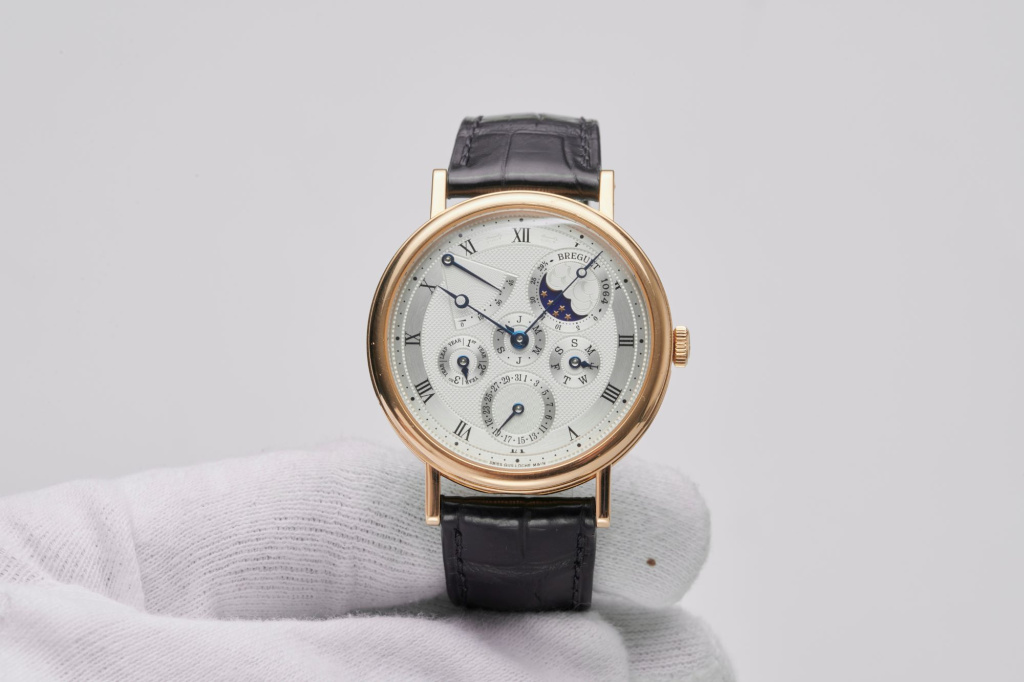
De Bethune DB15 Perpetual Calendar Ref. DB15WT No. 036 (Lot 06) in white gold, we find the classic perpetual calendar complication complemented by the brand’s signature 3D moon phase display. A De Bethune perpetual calendar at auction is always an event; it is a true collector’s rarity. Although the watch was launched 18 years ago, it is still relevant – both in technical and stylistic terms. This reference has been discontinued and is part of an exclusive numbered series of 45 pieces produced since 2004.
The Chopard Luna d’Oro Perpetual Calendar Édition Limitée No. 040/100 (Lot 04) in platinum and the Luna d’Oro Perpetual Calendar (Lot 04) in yellow gold are rare birds at auction. These watches, with an unusual dial arrangement and retrograde date, were made before the brand introduced in-house production of LUC calibers. The self-winding L.888 caliber with the ultra-thin Frédéric Piguet 71 base movement used a perpetual calendar module with retrograde date developed by independent watchmaker Svend Andersen. The perpetual calendar watches produced from 1994 onwards were called Luna d’Oro because their lunar disc was actually made of solid gold.
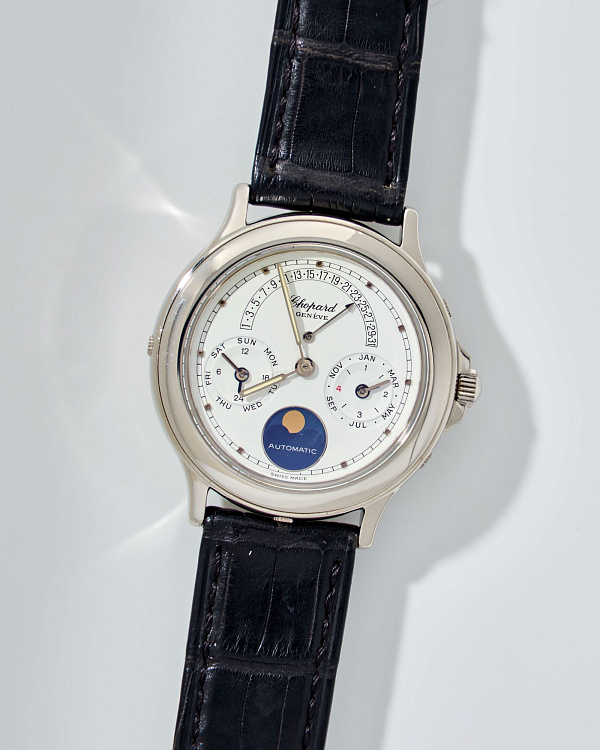
We also find a retrograde date on another rare bird (very rare!), the Jaquet Droz Perpetual Calendar Retrograde Date Série Limitée No. 15 of 15 (Lot 10) in white gold. The openworked dial gives this watch a look that is still up-to-date, as it reveals most of the high-quality perpetual calendar module with a haute horlogerie finish. What makes this watch special is the fact that it is of pre-Swatch Group period of the brand.
We complete the perpetual calendar overview at the It’s a Date: Calendar Watches auction with the Cvstos Challenge QP-S Perpetual Calendar No. 060 (Lot 20) a stainless-steel watch with an openworked dial. Cvstos is effectively Franck Muller’s second brand, and the Cvstos Challenge collection looks like a sporty, high-tech version of Franck Muller’s signature Cintrée Curvex design. This watch features a classic perpetual calendar with counters arranged along a cross. It is based on a personalized blackened self-winding Eta 2892-A2 movement and a perpetual calendar module by Dubois Dépraz.
The It’s a Date: Calendar Watches auction offers two watches with an annual calendar complication. We are very pleased to highlight the Patek Philippe Annual Calendar Chronograph Ref. 5905/1A-001 (Lot 13) in stainless steel with a bracelet and olive-green dial – as we have Patek Philippe to thank for this complication appearing on wristwatches. This watch is the only stainless-steel version of the 5905, which was launched in 2021, while this reference in platinum was introduced six years earlier, in 2015. The combination of the annual calendar and flyback chronograph complications was not new at the time, as it first appeared in Patek Philippe’s collection in 2006 in the reference 5960. The spiritual predecessor of this Annual Calendar Chronograph Ref. 5905/1A-001 is the much-acclaimed 2014 sporty edition 5960/1A-001 with white dial, blackened hands, blackened applied indexes and red accents and stainless-steel case and bracelet produced around the year. The introduction of this Ref. 5905/1A-001 did not cause a shock effect; this watch was mostly perceived as a modest, albeit sporty Patek Philippe with a double complication, intended for daily wear. We would like to highlight the charismatic olive green dial, which immediately evokes an association with another olive green dial Patek Philippe watch, the last non-limited Nautilus Ref. 5700/1A-014.

The second annual calendar watch in this auction is the < Laurent Ferrier Ecole Annual Calendar Steel Blue Piece Unique (Lot 15) in stainless steel with a dark blue dial and striking red accents. Laurent Ferrier’s remarkable craftsmanship in the exquisite design of a fully polished pebble-shaped case makes each watch from this brand a treasure, even if it is made of stainless steel. The annual calendar is a complication intended for everyday use. This was already the strategy of Patek Philippe, the inventor of this function. Laurent Ferrier compromises between this purpose and the collector’s destiny of a one-of-a-kind edition. Of course, the winner of the auction will have the privilege of resolving this apparent contradiction.
When it comes to big date watches, we are very proud to see a pair from A. Lange & Söhne in this auction, as it was the brand that introduced the big date to the modern wristwatch in 1994. The auction features watches from this brand where the big date is complemented by other complications: a time zone indicator in the Lange 1 Time Zone Ref. 116.032 (Lot 01) in rose gold, purchased by the original owner in 2008, and a flyback chronograph in the < Datograph Ref. 403.035 (Lot 02) in its original platinum version with black dial and silver-colored sub-dials. Both watches are collector classics. The Lange 1 Time Zone Ref. 116.032 was launched in 2005 and discontinued in 2019 as a new generation Ref. 136.032 was introduced. This rose gold version with solid gold and silvered dial offers a calm, balanced watch for everyday use. The Datograph Ref. 403.035 shows a different character. This is a magnificent watch, one of the best high-end chronographs of our time. Many who follow the outstanding independent watchmaker Philippe Dufour consider it the best. The brand introduced this reference in 1999 and ceased production in 2012. It was replaced by the updated Datograph Up/Down, which puts the original Datograph in the category of legends of modern watchmaking and collectors’ classics.
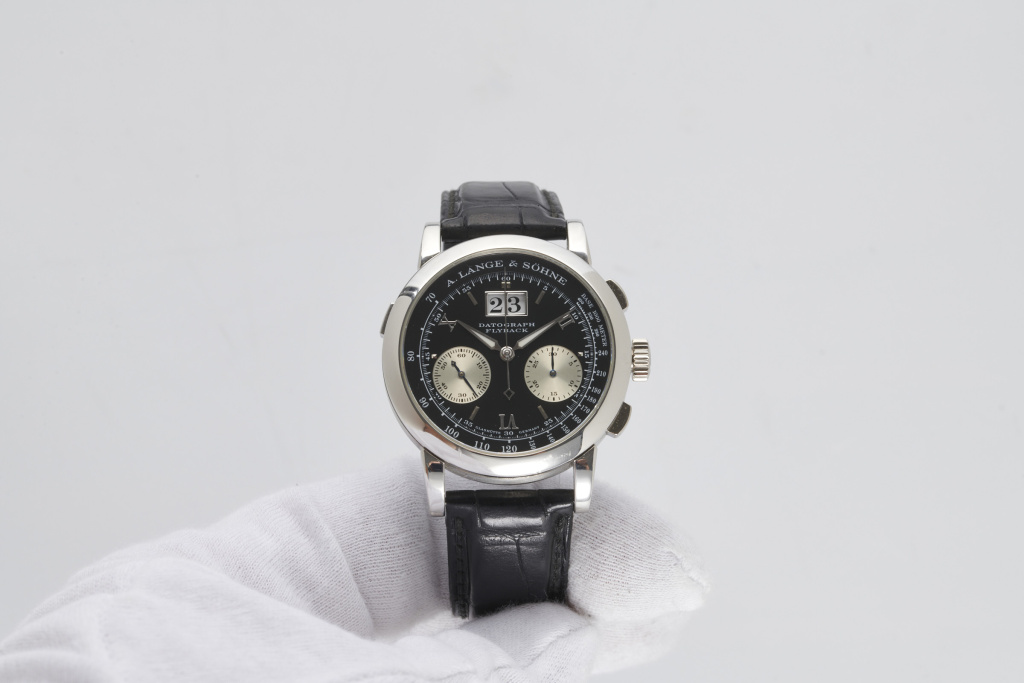
Vacheron Constantin Malte Ref. 42015/000G-8902 (Lot 19) in white gold, sold to the original owner in 2001, is an example of a watch that focuses on a single complication: a large date display. The silvered dial with a noble beige-grey patina, the Art Deco-style Arabic numerals printed in black and the square center zone give this watch the spirit of a military classic, which is extremely rare to find in the collection of this brand.
Closing the auction is the Audemars Piguet Royal Oak Dual Time Ref. 26120ST.OO.1220ST.01 Mk1 (Lot 30), a charismatic yet practical version of the Royal Oak ‘Jumbo’ design with a 39mm stainless steel case and sub-dials for date, dual time and power reserve on a matte white tapisserie dial. This watch, sold to the original owner in 2012, is a second-generation Royal Oak Dual Time, produced from about 2007 to 2015 as an update to the previous Dual Time Ref. 25730 – the first Royal Oaks with a GMT function. We have discovered two versions of Ref. 26120 with a larger (Mark 1) or smaller (Mark 2) continuous part of the power reserve scale, this watch belongs to the earlier Mk1 type.